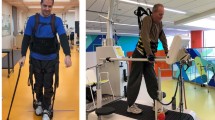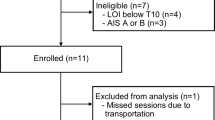Abstract
Introduction
Robotic Exoskeleton-assisted gait training is an emerging approach in spinal cord injury (SCI) rehabilitation. This case report evaluates the effectiveness of Powered-Robotic exoskeleton-based gait training in an individual with chronic paraplegia.
Case presentation
A 31-year-old male with T12 SCI due to fall underwent a four-week structured rehabilitation program incorporating powered robotic exoskeleton training (Exo-Rehabilitation) alongside conventional therapy. The patient participated in 15 sessions over four weeks of intervention, with progressive gait training phases, transition from assisted weight-bearing to independent crutch-assisted walking. Functional, neurological and psychological outcomes were assessed pre and post intervention. Clinical measures include, Function in sitting test (FIST), Walking Index for Spinal cord injury (WISCI-II), ISNSCI lower extremity motor scores (LEMS), Spinal Cord Independence measure (SCIM III), 6-min walk test (6MWT) and Quebec User Evaluation of Satisfaction with Assistive Technology 2.0 (QUEST 2.0). Patient reported outcomes and attendance were also recorded. The patient demonstrated better, sitting balance, and functional mobility, with enhanced psychological well-being and adherence to rehabilitation.
Discussion
Robotic Exoskeleton-assisted gait training may be safe and a feasible approach to improve mobility, balance, and functional independence in SCI patients. Robotic overground exoskeleton-based gait training may represent a significant step forward in bridging the gap between conventional therapy and advanced technology, offering new hope for functional recovery and independence in individuals with Chronic SCI.
This is a preview of subscription content, access via your institution
Access options
Subscribe to this journal
Receive 1 print issues and online access
We are sorry, but there is no personal subscription option available for your country.
Buy this article
- Purchase on SpringerLink
- Instant access to full article PDF
Prices may be subject to local taxes which are calculated during checkout







Similar content being viewed by others
References
World Health Organization, International Spinal Cord Society. In: Bickenbach J, editor. International Perspectives on Spinal Cord Injury. Geneva: World Health Organization; 2013.
Agarwal, P, Mishra, AN, Sudesh, W, Prachir, M, & Dhananjaya, S (2019). Priorities of desired functional recovery in Indian spinal cord injury patients. J Clin Orthop Trauma https://doi.org/10.1016/j.jcot.2019.08.001.
Tamburella F. Gait recovery in spinal cord injury subjects: from clinical experience to research developments. Sundhedsvidenskabelige Fakultet: Aalborg Universitet. Aalborg University; 2015.
Anderson KD. Targeting recovery: priorities of the spinal cord-injured population. J Neurotrauma. 2004;21:1371–83.
van Dijsseldonk RB, van Nes IJW, Geurts ACH, Keijsers NLW. Exoskeleton home and community use in people with complete spinal cord injury. Sci Rep. 2020;10:15600. https://doi.org/10.1038/s41598-020-72397-6.
Dobkin B, Apple D, Barbeau H, Basso M, Behrman A, Deforge D, et al. Weight-supported treadmill vs over-ground training for walking after acute incomplete SCI. Neurology. 2006;66:484–93. https://doi.org/10.1212/01.wnl.0000202600.72018.39.
Fineberg DB, Asselin P, Harel NY, Agranova-Breyter I, Kornfeld SD, Bauman WA, et al. Vertical ground reaction force-based analysis of powered exoskeleton-assisted walking in persons with motor-complete paraplegia. J Spinal Cord Med. 2013;36:313–21. https://doi.org/10.1179/2045772313Y.0000000126.
Morrison SA, Lorenz D, Eskay CP, Forrest GF, Basso DM. Longitudinal recovery and reduced costs after 120 sessions of locomotor training for motor incomplete spinal cord injury. Arch Phys Med Rehabil. 2017;S0003-9993:31285–6. https://doi.org/10.1016/j.apmr.2017.10.003.
Chilibeck PD, Guertin PA. Locomotor training and factors associated with blood glucose regulation after spinal cord injury. Curr Pharm Des. 2017;23:1834–44. https://doi.org/10.2174/1381612822666161216120546.
Lam T, Pauhl K, Ferguson A, Malik R, Krassioukov A, Eng JJ. Training with robot-applied resistance in people with motor-incomplete spinal cord injury: pilot study. J Rehabil Res Dev. 2015;52:113–29. https://doi.org/10.1682/JRRD.2014.03.0090.
Aach M, Cruciger O, Sczesny-Kaiser M, Höffken O, Meindl RCH, Tegenthoff M, et al. Voluntary driven exoskeleton as a new tool for rehabilitation in chronic spinal cord injury: a pilot study. Spine J. 2014;14:2847–53. https://doi.org/10.1016/j.spinee.2014.03.042.
Lester RM, Gorgey AS. Feasibility of robotic exoskeleton ambulation in a C4 person with incomplete spinal cord injury: a case report. Spinal Cord Ser Cases. 2018;4:36. https://doi.org/10.1038/s41394-018-0053-z.
Tamburella F, Lorusso M, Tramontano M, Fadlun S, Masciullo M, Scivoletto G. Overground robotic training effects on walking and secondary health conditions in individuals with spinal cord injury: systematic review. J NeuroEng Rehabil. 2022;19:27 https://doi.org/10.1186/s12984-022-01003-9.
Tamburella FMM, Pisotta I, Tagliamonte NL, Molinari M. Lower limb wearable systems for mobility and rehabilitation challenges: clinical focus. In: González-Vargas J, Ibáñez J, Contreras-Vidal J, van Kooij H, Pons J, editors. Wearable robotics: challenges and trends biosystems & biorobotics. New York: Springer; 2017.
Esquenazi A, Talaty M, Packel A, Saulino M. The ReWalk powered exoskeleton to restore ambulatory function to individuals with thoracic-level motor-complete spinal cord injury. Am J Phys Med Rehabil. 2012;91:911–21. https://doi.org/10.1097/PHM.0b013e318269d9a3.
Liu W, Chen J. The efficacy of exoskeleton robotic training on ambulation recovery in patients with spinal cord injury: a meta-analysis. J Spinal Cord Med. 2024;47:840–9. https://doi.org/10.1080/10790268.2023.2214482.
Gupta A, Prakash NB, Honavar PR. Gait training with robotic exoskeleton assisted rehabilitation system in patients with incomplete traumatic and non-traumatic spinal cord injury: a pilot study and review of literature. Ann Indian Acad Neurol. 2023;26:S26–S31. https://doi.org/10.4103/aian.aian_1075_21.
Baptista R, Salvaggio F, Cavallo C, Pizzocaro S, Galasso S, Schmid M, et al. Training-induced muscle fatigue with a powered lower-limb exoskeleton: a preliminary study on healthy subjects. Med Sci. 2022;10:55 https://doi.org/10.3390/medsci10040055.
Pais-Vieira C, Allahdad M, Neves-Amado J, Perrotta A, Morya E, Moioli R, et al. Method for positioning and rehabilitation training with the ExoAtlet ® powered exoskeleton. MethodsX. 2020;7:100849. https://doi.org/10.1016/j.mex.2020.100849.
Kirshblum S, Snider B, Rupp R, Read MS. International standards committee of ASIA and ISCoS. Updates of the international standards for neurologic classification of spinal cord injury: 2015 and 2019. Phys Med Rehabil Clin N. Am. 2020;31:319–30. https://doi.org/10.1016/j.pmr.2020.03.005.
Abou L, Sung J, Sosnoff JJ, Rice LA. Reliability and validity of the function in sitting test among non-ambulatory individuals with spinal cord injury. J Spinal Cord Med. 2020;43:846–53. https://doi.org/10.1080/10790268.2019.1605749.
Dobkin BH, Duncan PW. Should body weight–supported treadmill training and robotic-assistive steppers for locomotor training trot back to the starting gate?. Neurorehabil Neural Repair. 2012;26:308–17. https://doi.org/10.1177/1545968312439687.
Calabrò RS, Cacciola A, Bertè F, Manuli A, Leo A, Bramanti A, et al. Robotic gait rehabilitation and substitution devices in neurological disorders: where are we now?. Neurol Sci. 2016;37:503–14. https://doi.org/10.1007/s10072-016-2474-4.
He Y, Xu Y, Hai M, Feng Y, Liu P, Chen Z, et al. Exoskeleton-assisted rehabilitation and neuroplasticity in spinal cord injury. World Neurosurg. 2024;185:45–54. https://doi.org/10.1016/j.wneu.2024.01.167.
Demers L, Monette M, Lapierre Y, Arnold DL, Wolfson C. Reliability, validity, and applicability of the Quebec User Evaluation of Satisfaction with assistive Technology (QUEST 2.0) for adults with multiple sclerosis. Disabil Rehabil. 2002;24:21–30.
Contreras-Vidal JL, A Bhagat N, Brantley J, Cruz-Garza JG, He Y, Manley Q, et al. Powered exoskeletons for bipedal locomotion after spinal cord injury. J Neural Eng. 2016;13:031001 https://doi.org/10.1088/1741-2560/13/3/031001.
Grasmücke D, Zieriacks A, Jansen O, Fisahn C, Sczesny-Kaiser M, Wessling M, et al. Against the odds: what to expect in rehabilitation of chronic spinal cord injury with a neurologically controlled Hybrid Assistive Limb exoskeleton. A subgroup analysis of 55 patients according to age and lesion level. Neurosurg Focus. 2017;42:E15 https://doi.org/10.3171/2017.2.FOCUS171.
Baunsgaard CB, Nissen UV, Brust AK, Frotzler A, Ribeill C, Kalke YB, et al. Exoskeleton gait training after spinal cord injury: an exploratory study on secondary health conditions. J Rehabil Med. 2018;50:806–13. https://doi.org/10.2340/16501977-2372.
Corbianco S, Cavallini G, Dini M, Franzoni F, D’Avino C, Gerini A, et al. Energy cost and psychological impact of robotic-assisted gait training in people with spinal cord injury: effect of two different types of devices. Neurol Sci. 2021;42:3357–66. https://doi.org/10.1007/s10072-020-04954-w.
Mathur N, Jain S, Kumar N, Srivastava A, Purohit N, Patni A. Spinal cord injury: scenario in an Indian state. Spinal Cord. 2015;53:349–52.
Sharma R, Gaur P, Bhatt S, Joshi D. Optimal fuzzy logic-based control strategy for lower limb rehabilitation exoskeleton. Appl Soft Comput. 2021;105:107226.
Acknowledgements
Thanks to all team members who participated in this work.
Author information
Authors and Affiliations
Contributions
SSH (Sunpreet Singh Hanspal) conceptualized and designed the study, managed the patient, and drafted the manuscript. HSC (Dr. Harvinder Singh Chhabra) supervised the clinical process and critically reviewed the manuscript for intellectual content. AG (Ankush Gera) contributed to data acquisition and helped in interpretation of results. GS (Gouree Sengar) assisted in data analysis and manuscript editing. All authors read and approved the final manuscript.
Corresponding author
Ethics declarations
Competing interests
The authors declare no competing interests.
Ethics approval and consent to participate
All methods were performed in accordance with Institutional guidelines and regulations. The case report was determined not to require formal Ethics Committee (EC) or Institutional Review Board (IRB) review as it was a retrospective analysis of a single case. Written informed consent was obtained from the participant prior to participation in the exoskeleton-based rehabilitation program.
Consent for publication
Written informed consent was obtained from the participant for publication of the case report and all accompanying identifiable images.
Additional information
Publisher’s note Springer Nature remains neutral with regard to jurisdictional claims in published maps and institutional affiliations.
Rights and permissions
Springer Nature or its licensor (e.g. a society or other partner) holds exclusive rights to this article under a publishing agreement with the author(s) or other rightsholder(s); author self-archiving of the accepted manuscript version of this article is solely governed by the terms of such publishing agreement and applicable law.
About this article
Cite this article
Hanspal, S.S., Chhabra, H.S., Gera, A. et al. Gait training using powered robotic exoskeleton for a person with spinal cord injury: a case report. Spinal Cord Ser Cases 11, 23 (2025). https://doi.org/10.1038/s41394-025-00716-y
Received:
Revised:
Accepted:
Published:
DOI: https://doi.org/10.1038/s41394-025-00716-y



